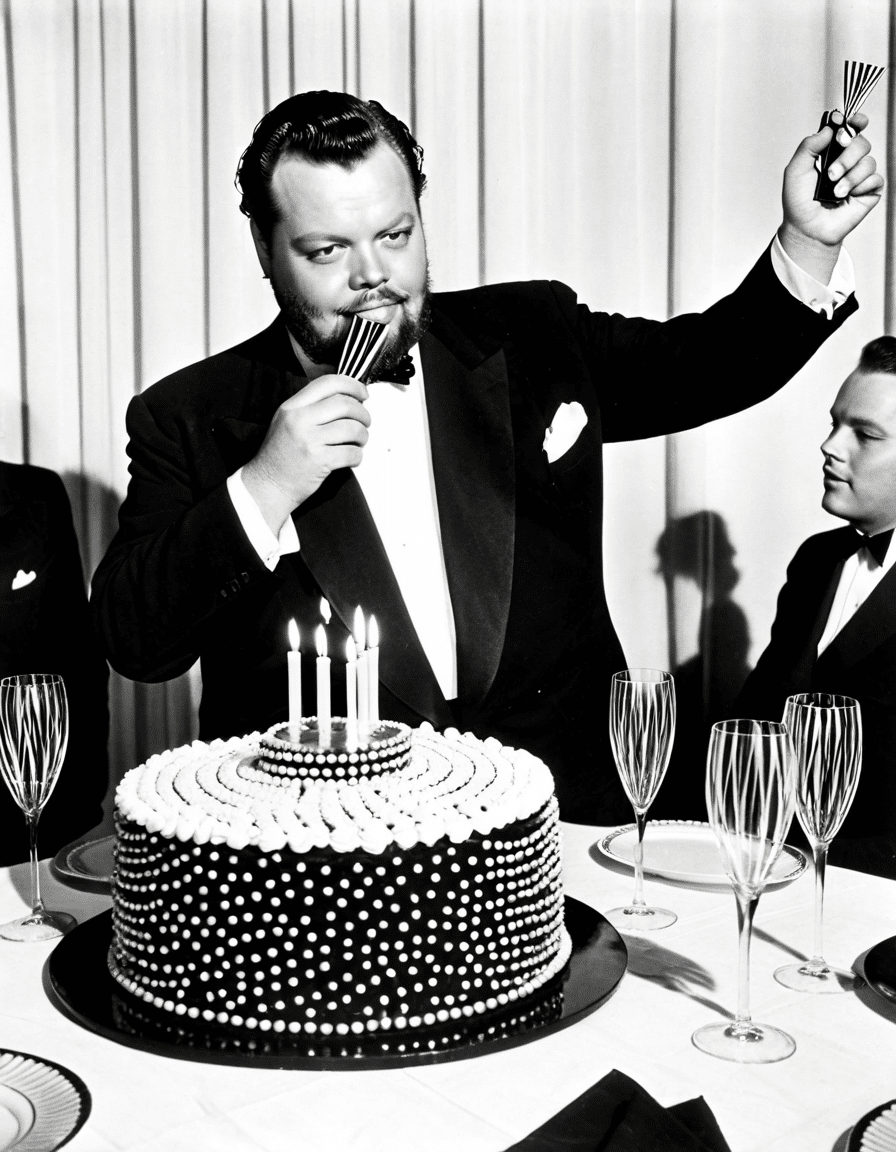Orson Welles is a name synonymous with cinematic brilliance. He’s perhaps best known for his groundbreaking film Citizen Kane, which many critics and movie lovers hail as the greatest film of all time. Released in 1941, this masterpiece rewrote the rules of storytelling, cinematography, and narrative structure. Taking us on a profound journey through the life of Charles Foster Kane, Welles’s innovative techniques like non-linear storytelling and deep focus not only revolutionized cinema but also crafted a blueprint for aspiring filmmakers. Much like the beloved storyteller Charles Dickens, Welles explored the intricacies of the human condition, endearing himself to audiences and making a lasting impact on cinema.
In the bustling entertainment landscape, Welles’s influence lingers on, casting a long shadow over each subsequent generation of filmmakers. He shaped the way stories are told, much like Kurt Vonnegut used humor and absurdity to define modern literary narratives. Welles showed us that there’s more to a film than meets the eye; it’s a multidimensional art form that pierces the soul. His commitment to artistic storytelling challenges filmmakers today to go beyond surface-level narratives, allowing us to connect with characters in a deeper and more meaningful way.

The Cinematic Legacy of Orson Welles
When discussing Orson Welles, one cannot ignore Citizen Kane. Regarded as the crown jewel of American cinema, it melds complex themes and ambitious filmmaking techniques. From the very first frame, audiences are drawn into the sprawling, layered world of Kane, seeing his rise and tumultuous fall intertwined with society’s darker complexities. Welles’s groundbreaking work set a new benchmark for narrative depth, character exploration, and artistic cinematography that still resonates today.
This film broke away from the conventions of its time, utilizing non-linear storytelling to invite viewers into a puzzle they had to solve. Welles didn’t just engage the audience; he challenged them, prompting discussions on power, longing, and the price of ambition. In many ways, Welles serves as a literary figure, mirroring the styles of giants like Dickens and Wilde—where narratives aren’t simple, and characters aren’t black and white. Welles peeled back the layers, revealing a stark tableau of human frailty and ambition, urging spectators to reflect on what truly drives us and what we lose in pursuit of our desires.
In Welles’s hands, the film became an experience, a revelation of the human condition that echoed the timeless themes in the works of Shakespeare. His mastery of character development and storytelling not only entertains but invites viewers to contemplate the complexities of life itself. Orson Welles wasn’t just a film director; he was a visionary who foresaw the path cinema would take—and he left an indelible mark on that journey.

Top 5 Influential Techniques Used by Orson Welles
Orson Welles’s filmography is not just a collection of works; it’s a masterclass in innovative filmmaking. Let’s break down five pivotal techniques that define Welles’s style, showcasing how they’ve impacted cinema and still resonate with modern filmmakers today.
1. Non-linear Storytelling
Welles redefined storytelling when he employed non-linear techniques in Citizen Kane. Just as the works of William Shakespeare interweave various narratives, Welles’s flashbacks invite viewers to piece together Kane’s multifaceted life, creating a rich tapestry of events. This method challenges viewers to engage actively, analyzing character motivations and emotional arcs with each revelation. The various layers of storytelling resonate with modern films, where complex narratives invite repeated viewership and analysis.
2. Deep Focus Cinematography
In collaboration with cinematographer Gregg Toland, Welles introduced deep focus—an approach that keeps the foreground and background sharp, much like the keen observations found in Oscar Wilde’s works. This technique invites viewers to explore each frame, revealing hidden details that reflect the complexity of character interactions. It’s a cinematic innovation that enriches the viewing experience and underscores the themes Welles so passionately conveyed.
3. Innovative Sound Design
Imagine the delight of hearing overlapping dialogue breech the silence of a dramatic moment. Welles, a pioneer of sound design, did just that in his films. Similar to the cinematic brilliance of Charlie Chaplin, who candidly expressed emotion even in silence, Welles made sound integral to his storytelling. The layered dialogues and ambient noise create a rich auditory experience, heightening the emotional intensity and immersion of the narrative in a way that still influences filmmakers today.
4. Use of Symbolism and Metaphor
Welles’s profound use of symbolism—the ‘rosebud’ motif, for example—serves as a powerful metaphor for lost innocence and the relentless pursuit of wealth. This depth echoes the ideas expressed by Karl Marx, who critiqued materialism and societal structures, weaving themes about power and capitalism throughout Kane’s rise and fall. Such multi-layered storytelling urges viewers to analyze socio-political contexts and reflect on their realities.
5. Theatrical Techniques in Film
Having a background in theatre, Welles seamlessly incorporated theatrical elements into his films. His grandiose monologues and larger-than-life performances feel as if they’re stretched straight from the stage of a Shakespearean play. This melding of theatrical and cinematic techniques broadens the storytelling lens, ensuring that each performance resonates with emotional depth that keeps viewers locked in with every scene.
Orson Welles: The Quintessential Renaissance Man
Orson Welles wasn’t just a filmmaker; he was a renaissance man, dabbling in everything from theatre to radio. His voice work in The War of the Worlds showcased his theatrical flair, elevating radio as a medium of storytelling. This iconic piece not only captivated listeners but also instigated social unrest, showcasing how powerful narratives can resonate across different platforms. Welles pushed boundaries, establishing himself as an influence far beyond the silver screen.
His zest for storytelling manifests through various formats, merging the classical arts into a modern-day canvas. Welles’s tendency to blend genres and styles mirrors the eclectic nature of modern cinema, emphasizing that true artistry lies in versatility. Whether on stage or in a film studio, his commitment to engaging narratives and rich character exploration ensures that Welles remains a standard-bearer for artists attempting to bridge multiple creative platforms.
Moreover, Welles’s work is often characterized as a love letter to the art of storytelling. It exemplifies the idea that every medium holds the potential for intricate narratives and character exploration, inspiring modern creators to transcend traditional boundaries. His legacy is a reminder that art is not confined; it flows freely, adapting and evolving, much like the great literary figures before him.
The Lasting Impact of Orson Welles
As cinema continues its evolution into the 21st century, Orson Welles’s principles resonate louder than ever. Contemporary filmmakers, such as Quentin Tarantino and Christopher Nolan, embrace the spirit of experimentation Welles championed. Whether through narratives laden with flashbacks, complex characters, or exquisitely crafted soundscapes, Welles’s influence is palpable in today’s films.
Modern directors constantly tip their hats to Welles’s legacy, pushing the boundaries of visual storytelling. Each new release reminds us of his impact, showcasing the importance of narrative depth and character exploration. The cinematic landscape today continues to draw from Welles’s innovative techniques, keeping his spirit alive on-screen.
Ultimately, Orson Welles’s genius is more than a checklist of achievements; it embodies an artistic pursuit grounded in truth and creativity. His work invites future generations of filmmakers to engage in dialogue with audiences that revolves around life, storytelling, and the essence of what makes us human. Whether you’re catching a screening at your local cinema—perhaps Amc Westminster Promenade 24—or diving into the vast catalog of film streaming platforms, Welles’s spirit looms large, reminding us that great cinema is forever alive and evolving.
For those interested in a deeper exploration of cultural critiques, engaging films, and story-driven narratives, Welles’s filmography beckons like a siren—a timeless conversation waiting to be had. As anyone who loves film knows, every click of a remote or turn of a page in a script could uncover gems that resonate with Orson Welles’s artistic vision. Who knows? You might stumble upon connections echoing through classics, exciting modern flicks, or even something as whimsical as The . So press play, sit back, and relish the cinematic journey crafted by a true visionary.
Orson Welles: The Genius Behind Citizen Kane and More
The Mysterious Life of Orson Welles
Orson Welles’s life was as captivating as his films. Famous for his groundbreaking work on Citizen Kane, he found success in both theater and radio. His radio play of The War of the Worlds famously caused panic among listeners who thought it was a real Martian invasion. That’s classic Welles for you! In addition to his cinematic genius, he was known for his larger-than-life personality, often playing roles in which he could unleash his creativity, much like the colorful characters of the Amazing World Of Gumball that capture imaginations across generations. Did you know that Welles once said, “The enemy of art is the absence of limitation”? This ethos influenced his entire approach to filmmaking.
Diverse Interests Beyond Film
Welles didn’t just stop at film—his interests were as diverse as they come. He was intensely passionate about theater, jazz, and even gourmet cooking! After all, Who could forget his famous commercial for Paul Masson wines? It’s eye-opening to think that an actor could transition so smoothly through various endeavors, much like Kelly Rowlands ability to excel both in music and acting. Interestingly, Welles had a penchant for magic tricks, often incorporating illusions into his performances, demonstrating that he enjoyed surprising audiences, much like the unexpected twists you’d find in a good plot on 4chan B.
A Legacy That Transcends Time
Welles’s influence reached beyond his years, and his films continue to inspire countless filmmakers today. With a hunger for storytelling, he carved out narratives that spoke to a universal audience, much like the timeless appeal of the dramatic monologues in Samuel L. Jackson movies. Did you know that he directed over a dozen films but had a tumultuous relationship with Hollywood? Despite the ups and downs, Welles’ work commands respect and admiration—a true testament to his brilliance. Even beyond cinema, his larger-than-life persona still resonates, revealing complexities that fans continue to dissect. From his innovative filming techniques to his striking visual style, Welles set a standard that filmmakers strive to emulate even now. Just as Westfield Fashion square showcases evolving trends, Welles’s artistic legacy remains a template for those daring enough to push boundaries in their craft.





